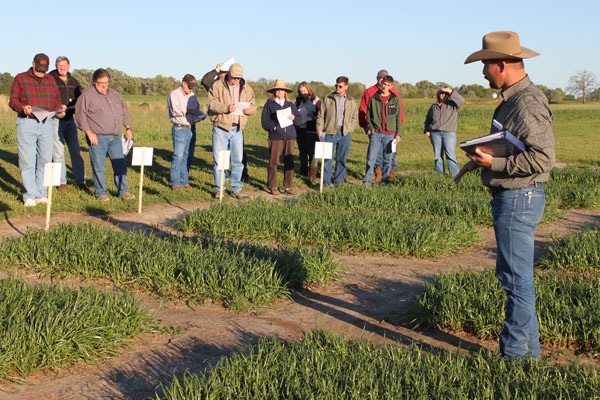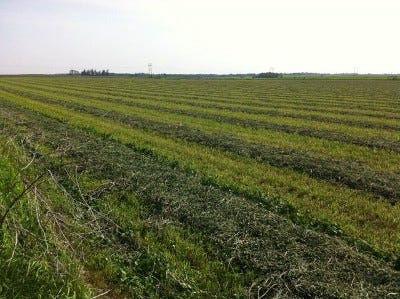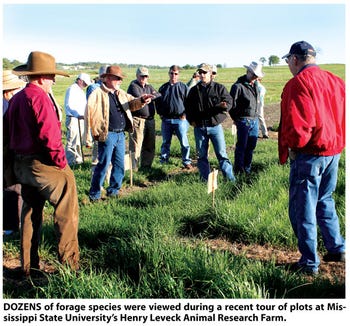
Use of cool-season forages can allow livestock producers to extend the grazing season and reduce the need for stored feeds, according to Mississippi State University forage specialists. Mississippi producers are fortunate to be able to grow a large number of forage crops, says Rocky Lemus, MSU Extension assistant professor of plant and soil sciences, including warm- and cool-season species of legumes and grasses, and both perennial and annual forages are common.

Use of cool-season forages can allow livestock producers to extend the grazing season and reduce the need for stored feeds, according to Mississippi State University forage specialists.
Producers got a firsthand look at dozens of cool season grasses and legumes during a tour of plots on the university’s Henry Leveck Animal Research Farm.
“There are about 400,000 to 500,000 acres seeded to winter forages in the state,” said Rocky Lemus, assistant Extension professor of plant and soil sciences, “but there is opportunity for many more producers to benefit from utilizing these crops. Our studies are aimed at determining how these winter forage varieties perform and their suitability for production in Mississippi.”
 Mississippi livestock producers are fortunate to be able to grow a large number of forage crops, Lemus says, including both warm- and cool-season species of legumes and grasses, and both perennial and annual forages are common.
Mississippi livestock producers are fortunate to be able to grow a large number of forage crops, Lemus says, including both warm- and cool-season species of legumes and grasses, and both perennial and annual forages are common.
Annual ryegrass and small grains, such as oats, wheat, and rye are widely-used winter annual grasses, along with perennial cool season legumes such as white and red clover, and annual legumes, including crimson, ball berseem, and arrowleaf clovers. Tall fescue is grown extensively in the prairie areas of the state and in north Mississippi.
Warm-season forages include perennial grasses such as bermudagrass and bahaigrass, sorghum-sudan hybrids and pearl millets, and annual legumes such as annual lespedeza and alyce clover.
“By using a combination of cool- and warm-season forages for grazing and hay, many Mississippi livestock producers are able to grow their needed feeds with very few outside purchases,” Lemus says.
“If you balance cattle numbers with the land area you have for growing pasture and hay, you may be able to grow all the feed you need. This may average two to three acres per cow-calf unit, but can vary with land type, forage species, fertility, animal requirements, and environmental conditions.”
“By using both cool- and warm-season grasses for grazing and hay, a balance can be reached over time. Rotation grazing may increase carrying capacity and forage utilization.”
He says many growers ask, “What is the best hay grass I can grow?”
“You shouldn’t confuse best with most,” Lemus says. “Also, you must have well-drained land to grow the better hay grasses.
“Bahiagrass grows all over south Mississippi, but might not make the highest quality hay. Dallisgrass grows better than bahiagrass and bermudagrass on moist bottom soils, but ergot in the seedheads may be a problem in hay. Hybrid - - bermudagrass will produce a large quantity of high quality hay, but usually require more management than other summer grasses.”
Extend grazing season, cut costs
Utilizing cool-season forages can extend the grazing season and reduce the need for stored feed, Lemus says. There are several reasons this is beneficial:
• It is better for the environment. Feeding hay or stored materials in a barn or other enclosed are concentrates animals and the accumulated manure results in an expense for removal. Feeding them in pastures often results in hoof damage to the land.
• Weather is less a concern. Animals can graze almost without regard to weather.
• Higher quality forage leads to better animal performance. The quality of young, vegetative pasture growth and even leafy autumn residue is usually considerably higher than that of hay.
 • It requires less labor than to provide animals with stored feed and to remove manure from enclosed areas.
• It requires less labor than to provide animals with stored feed and to remove manure from enclosed areas.
• It reduces expenses. Stored feed is almost always two to three times more expensive per animal or per day than pasture. In livestock budgets, stored feed typically accounts for 40-50 percent or more of the cost of production, and many producer’s records show it to be even higher.
“In general, the less hay needed, the more cost-efficient the operation,” Lemus says. “Clearly extending the grazing season and reducing the need for stored feed is highly desirable.
On the plots tour, Ph.D. graduate student Brett Rushing, noted “there is a lot of interest in planting native grasses, both for forage production and wildlife habitat. We’re looking at orchardgrass and fescue varieties in comparison to native ryegrasses.
“There are seven ryegrass species that are native to the Southeast. They are somewhat tough to establish in the first year, but we’re hoping that in subsequent years they can provide both forage and wildlife habitat. So far, they have not yielded as well as the fescues and orchardgrass.”
David Lang, MSU associate professor of plant and soil sciences, said a number of annual, biennial, and perennial clover species are being evaluated for planting into warm season grasses.
“White clover is a good choice for planting into bermudagrass, and can last for five to 10 years,” he notes. “We’re also evaluating some arrowleaf clovers that were developed in Mississippi.”
In addition to their forage value, planting clovers into warm season grasses can help provide nitrogen for the grasses, he says.
Ryegrass mixtures
Mississippi State University has been evaluating ryegrasses at four locations in the state for 35 years or more, Lemus says, seeking ways to obtain more uniform production. “We’re also looking at mixtures of early- and late-maturing varieties to see if they can offer an advantage over planting a single variety.”
Tetraploid varieties are more suited to the southern areas of the state, he says, while diploid varieties perform better in the northern areas.
Comparisons of mixtures to Marshall, a long-used variety, have shown yield advantages from 236 pounds per acre (Bulldog Grazer) to 408 pounds (Chipola plus Marshall) to 612 pounds (TAM TBO). Yields were from three harvests in an ongoing study.
Mixtures were planted Oct. 20, 2010, at 30 pounds per acre, split equally between the two varieties. Fertilization was 150 pounds of nitrogen as ammonium nitrate per acre in split application of 50 pounds two weeks after emergence, 50 pounds after first cut, 25 pounds each after second and third cuts.
“We also plan to do an economic analysis of the mixtures versus monoculture,” Lemus notes.
He cautioned that forage producers need to be careful when considering the use of products being offered to enhance nitrogen utilization or to limit nitrogen volatilization.
“In our tests, when compared to the control, we do see an increase in yield for most of these products — but, it often is only a slight increase that might not offset the cost of the product and application.
“Also, with cool temperatures early in the season, there is not a lot of nitrogen volatilization, so even if you’re considering using one of these products, you may not want to do so with your first application.”
At the fescue plots, Lemus said “most fescues in Mississippi do well for three or four years, then stands start to decline.”
It costs $80 to $100 per acre to establish MaxQ, a widely-used variety, he says. “There are some new, novel endophyte varieties that have been tested with significant animal performance when compared to MaxQ , but they are not cot commercially available at the moment.
“We’re also looking at seven endophyte-free varieties, alone and with white and red clover. These varieties can last four or five years and cost only about $30 to $40 per acre to establish. We will also evaluate them for economics and performance.”
Fescues have to be carefully managed in the spring, and shouldn’t be grazed until they are well-established, Lemus says.
“The main reason fescues don’t work well for many producers is that they see the plants greening up and immediately start grazing — but you need to babysit fescue until it gets established.”
Annual, perennial clovers
The MSU research plots include 24 different varieties of annual and perennial clovers, including arrowleaf, ball, berseem, crimson, Persian, subterranean, red, and white, and common hairy vetch.
“We don’t have a lot of data on clover production in Mississippi,” Lemus says, “and we want to see what kind of production these varieties can provide over four or five years. We’ll also soil sample every summer to estimate how much nitrogen contribution they are making.
“Clover isn’t for everyone. You need to have a good pH, preferably in the 6-and-up range, along with optimum phosphorus and potassium. It’s very important to apply lime, if necessary, to get the proper pH, and to choose varieties carefully for your particular location and production system.”
In MSU tests in 2010, annual crimson clover produced the highest yield per acre, 1,189 pounds, followed by Yuchi arrowleaf, with 1,050 pounds, and common hairy vetch, with 726 pounds after one cut.
“You’ve probably heard many times that we can’t grow alfalfa in Mississippi,” Lemus told producers.
“Yes, we can — but, you must be willing to meet the requirements of the crop, and you must have the proper soil and soil conditions.
“Alfalfa requires a deep, well-drained soil with good internal and surface drainage, with a pH of 6.5 to 7.0. If lime is applied before planting, time must be allowed for the pH to adjust.”
There can also be problems from fungal diseases such as sclerotina, that can kill the root system, and aphids may be a problem in spring or fall.
“We have 12 different varieties of differing dormancies in our trials, and right now all look really good,” Lemus says. “They were planted last fall at a seeding rate of 20 pounds per acre.”
In 2010 trials at the White Sand Experiment Station, fall dormancy varieties yielded from 3,306 pounds per acre to 5,779 pounds per acre.
Monsanto is now marketing Roundup Ready alfalfa, Lemus notes, and “we think two of those varieties may have a fit in Mississippi.”
He cautions growers to “be aware that if you plant the Roundup Ready varieties, you have to keep records of where you plant them and you have to cut them at 10 percent bloom so they won’t go to seed — which means they can’t be used in wildlife food plots.” Producers should follow the environmental stewardship guidelines offered with the round-up ready varieties.
The forage tour was hosted by the Mississippi State University Forage Extension Program, the Oktibbeha County Extension Service, and Wax seed Company.
The MSU Extension forage program will conduct four grazing schools this year, one in each region of the state. Dates/locations are May 26, Brookhaven; June 2, Prairie; Sept. 22, Poplarville; and Sept. 29, Batesville. The one-day schools will cover diverse forage topics and include hands-on demonstrations. Details may be obtained from Mississippi county Extension offices.
About the Author(s)
You May Also Like



